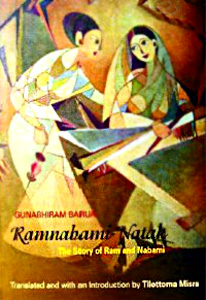 Important writers of the Orunodoi era provide a clearer idea of the literature of the time. A discussion of the writers in context of their work throws ample light on the development of particular genres. The three most important writers through who contributed immensely to the literary works in the Orunodoi era are Anandaram Dhekiyal Phookan, Hemchandra Barua, and Gunabhiram Barua.
Important writers of the Orunodoi era provide a clearer idea of the literature of the time. A discussion of the writers in context of their work throws ample light on the development of particular genres. The three most important writers through who contributed immensely to the literary works in the Orunodoi era are Anandaram Dhekiyal Phookan, Hemchandra Barua, and Gunabhiram Barua.
Anandaram Dhekiyal Phookan (1829-59)
Anandaram Dhekiyal Phookan was one of the earliest contributors to the Orunodoi. He was also one of the active participants with the Baptist missionaries to remove the Bengali language from Assam. He was in a particularly advantageous position, as he was an officer of the provincial administration and rose to the post of junior assistant to the commissioner. His essay "A Few Remarks on the Assamese Language" (1855), published anonymously as "A Native," contains an account and analysis of 62 religious poetical works and 40 dramatic works. The putting together of such a list was particularly significant as evidence of a literary tradition in Assam. It validated the claims that Assamese was a language rather than a dialect, as had been supposed.
Dhekiyal Phookan not only brought Assamese literature to the attention of the world at large, he also brought information about the world to Assamese readers. His unfinished series Asamiya Lorar Mitra (Assamese Boy`s Companion, 1849) was written as handbooks containing information on various subjects such as history, geography, and science. Besides his use of modern prose, he attempted to write trans-lingual Assamese-English dictionaries, which were left unfinished but parts of which appeared in Orunodoi.
The simple, clear, efficient prose that modern Assamese literature adopted is best exemplified by Dhekiyal Phookan`s essay "Englandor Vivaran". In it, he addresses the readers, the Assamese people, directly, as he calls to them to emulate the civilization and progress that were England`s. However, the message is a call not to mimic English ways but rather to improve one`s own country. The picture that he paints of the possible future, of an Assam rich in industry and learning and free of communal and racial bigotry, shows him to be rather a visionary.
Hemchandra Barua (1835-96)
Hemchandra Barua`s contribution was linguistic as well as literary. The most important work of Hemchandra Barua was his `Hemkosh` (Golden Treasury), an Anglo-Assamese dictionary published posthumously in 1900. Barua`s articles in Orunodoi, his dictionaries, and his grammatical texts all sought to replace the simplified Assamese language used by the missionaries with a version closer to Sanskrit patterns of speech and to strengthen the use of Assamese by native speakers. Among these were `Asamiya Vyakaran` (1873), `Asamiya Lorar Vyakaran` (1892), and `Pathsalia Abhidan` (1892). His literature, too, reveals a concern for social reform. His novel `Bahire Rongsong Bhitore Kowan Bhaturi` (1876) refers to the idiom "empty vessels make most sound" and criticizes social customs and religious hypocrisy through the supposedly respectable characters.
In his life, too, he protested against restrictions on widow remarriage. He protested the double standard by refusing to remarry, though widowed at an early age. An article in Orunodoi entitled `Anek Bia Kora Ajugut` (It Is Wrong to Marry Many), attributed to a `Shri Sonar Chanda,` was obviously by him. His drama `Kaniyar Kirtan` (The Gospel of an Opiumeater, 1861) highlights the effects of opium. In later years, Hemchandra Barua edited an Anglo-Assamese weekly paper, Assam News, which ensured the influence of his linguistic practices on following generations.
In his personality and his place in the literature of his time, Hemchandra Barua is quite often likened to Samuel Johnson. However, it must be pointed out that, though Johnson`s dictionary was a prodigious work by a single individual, it did not reshape his native language, English. Hemchandra Barua`s dictionary did reshape Assamese.
Gunabhiram Barua (1837-94)
Like Hemchandra Barua, Gunabhiram Barua was an ardent social reformer whose work reveals his reformist zeal. His `Ram-Navami` (1858), the first modern Assamese play, focuses on widow remarriage through the character of Navami, a young widow in love with a young man, Ramachandra. The discovery of this love leads to religious ostracism; however, the religious leader later recounts a dream that he had advocating remarriage, and the play ends with Navami`s remarriage. Despite this happy ending, the ostracism is not removed. The play thus advocates widow remarriage while criticizing the practice of ostracism. In keeping with his beliefs, Gunabhiram Barua married a widow, Bishnupriya, after his first wife`s death.
Gunabhiram Barua was also the first Assamese biographer with his `Anandaram Dhekiyal Phookanar Jivan Sarit` (1880). His humorous work `Kalhin Shabdar Rahasya Byakhya` (published posthumously in 1912) contains wonderfully comic interpretations of words. Gunabhiram Barua`s other contribution was to the literary essay. `Asom Bandhu` (Friend of Assam), a journal that he edited from 1885 to 1886, carried numerous essays by him and other early essayists. His prose is extremely modern in that it rejects declamation and opts for naturalness and directness. The simplicity, strength, and clarity of his prose style in such articles as `Saumar Bhraman` and `Alikhit Buranji,` which appeared in Jonaki, were carried over to the next generation of prose writers.
These three nineteenth-century writers made the most significant contribution to the literature in the Orunodoi era. It was these three nineteenth century writers who established the foundations upon which the literary writers of the Jonaki era would thrive.













